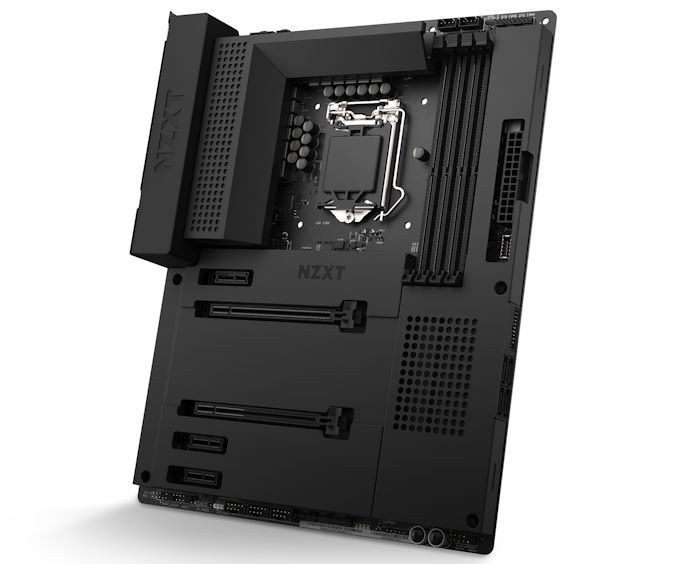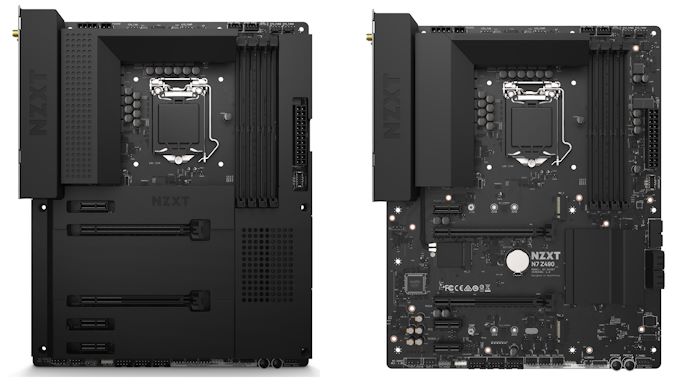The NZXT N7 Z490 Motherboard Review: From A Different Direction
by Gavin Bonshor on October 7, 2020 10:30 AM EST- Posted in
- Motherboards
- Intel
- ASRock
- NZXT
- Z490
- Comet Lake
- Intel 10th Gen
- i7-10700K
- N7 Z490

It's been nearly two years to the day since NZXT last released a motherboard, which was the Z370 N7. NZXT initially used ECS as its motherboard OEM, but has opted to use ASRock this time round for a new N7 model. This has the same N7 infused armor, albeit using a combined metal and plastic instead of just metal which does reduce the overall cost. Aiming for the mid-range market, NZXT's N7 Z490 features 2.5 GbE, Wi-Fi 6, dual M.2, and four SATA ports, and we give it our focus in this review.
The N7 Z490: Going For Mass Effect
At the beginning of September, NZXT reached out to me explaining that they intended to launch a new motherboard into an already cramped Z490 market. One of the elements NZXT wanted to address over its motherboard offerings was the firmware and overclocking, given that ECS isn't really a popular name on those two fronts. This time around, NZXT has leveraged ASRock's services for the underlying platform, on top of which NZXT has layered its own styling and form.
Armed and equipped with a reasonable mid-ranged feature set, the NZXT N7 Z490 includes a premium HD audio codec, combined with 2.5 GbE and an Intel Wi-Fi 6 interface. Perhaps one of the most notable features is the boards full cover armor plating (plastic and metal), which users familiar with NZXT's previous motherboards will recognize. It stretches across the entirety of the PCB, only showing the CPU socket area, memory slots, and the top and bottom edges of the board.
Looking at memory support closer, the N7 Z490 includes the capacity to install up to 128 GB, with speeds of up to DDR4-4266 supported. This is a couple of pegs lower than other models on the market, but the likelihood of regular users opting for higher speeds than this is likely to be slim due to cost. The board uses two PCIe 3.0 x4 M.2 slots for storage, with four SATA ports available. On the rear panel, the N7 Z490 uses just two USB 3.2 G2 ports, a single Type-C, and just one Type-A, with two USB 3.2 G1 Type-A and two USB 2.0 ports.
In our performance testing, the N7 Z490 performed and behaved like any other Z490 board we've tested from ASRock. We saw the N7 Z490 do well in our Non-UEFI POST time test, get a good result in our DPC latency test, and observed competitive performance in our computational and gaming benchmarks. Overall, for any stock level performance, it was hard to find fault with the board.
For overclocking, the NZXT N7 Z490 performed better than any NZXT board I've tested so far (I've owned all of them). Similar to other ASRock models, when adjusting the CPU VCore voltage in the firmware, it reverts the LLC profile to level 1 for tighter and aggressive VDroop control. It feels as if the firmware isn't quite polished to the standard we would expect for release - in our manual overclock testing, setting 1.250 V in the firmware at 4.8 GHz, all cores gave us a load VCore of 1.384 V, which is way too much. This presented even more problems at higher overclocks and caused a lot of downclocking, which skewed our results, with a possible issue within the board's loadline calibration profile settings. More info on this in the review.
The NZXT N7 Z490 has an MSRP of $230, which puts it in direct competition with models such as the ASRock Z490 PG Velocita ($235), the GIGABYTE Z490 Aorus Elite AC ($220), and the ASUS Prime Z490-A ($230). All of the competing models include support for faster memory, more SATA ports, with the ASUS model offering better USB 3.2 G2 connectivity. What NZXT has squarely in its favor is a competitive networking combination, with a unique and uniformed aesthetic due to the PCB armor, which looks great. The crux of the matter is whether or not the NZXT N7 Z490 steps up to the challenge in our test suite.
Read on for our extended analysis and comparison tests.














45 Comments
View All Comments
meacupla - Wednesday, October 7, 2020 - link
what, only 6 USB ports on the back?It should be 8 minimum for 2020.
eek2121 - Wednesday, October 7, 2020 - link
Not really? In the back of my machine right now I have a keyboard, mouse, and mic plugged in. In the front I range from 0-2 devices depending on what I am doing.Arsenica - Wednesday, October 7, 2020 - link
As a case manufacturer they should be focused on having lots of front ports.2 Type-C front connectors should be the bare minimum (this MB one has 1) and for the next generation they should be thinking on ways to bring Thunderbolt 4 to the front ports.
tmanini - Friday, October 9, 2020 - link
last I looked the trace length for thunderbolt from controller to port was something like 2 inches. PCIe traces can only go so far and have geometric considerations for impedance and jitter. Getting one on the front of a tower isn't so simple.Arsenica - Sunday, October 11, 2020 - link
In that case a front panel integrated TB hub may be the solution.snowmyr - Wednesday, October 7, 2020 - link
Yeah but, and hear me out on this shocker: you aren't everyone.meacupla - Thursday, October 8, 2020 - link
Yes really.Mouse, 1 port
Keyboard, 2 ports
Game controller, 1 port
Wireless headset dongle, 1 port
USB capture card, 1 port
oh, look, that's 6 ports used.
Seriously, this mobo costs $230. Why would you settle for less USB ports on the back?
OMGWhyMe - Thursday, October 8, 2020 - link
Which keyboard uses 2 ports?IKROWNI - Thursday, October 8, 2020 - link
I have a g910 which uses 2 usb ports. My son has a corsair that uses 2 usb ports.I have a
dragonfly black usb dac (1 port)
Logitech g910 (2 port)
Bose speakers (1 port)
Blue yeti mic (1 port)
Valve index (3 port)
Phone charging cable (1 port)
Logitech power play mouse pad (1 port)
Logitech g502 lightspeed mouse (1 port)
Xbox controller dongle (1 port)
Extra micro charge cable for programming various esp8266 devices (1 port)
So yea I'd love a mobo with more usb ports
littlebitstrouds - Friday, October 9, 2020 - link
And that's why you're on ryzen no? expansion possibilities... go buy a USB card or two... or usb dock. Half these issues have easy solutions, not to mention you wouldn't want that many cables coming out of your computer anyway, it's messy. Get a dock.